What should you look for when choosing fly-tying scissors? Well, that all depends on a number of factors. This article takes an in-depth look at one of the fly tier's most important tools.
Contents
- Skimping
- Caving in
- More scissors
- My personal choice
- Tightness and sharpness
- Smooth or serrated
- Shape
- Eyes
- Blade material
- Sharpness
- Straight/curved
- Blade length
- Blade shape and tips
- Making your scissors last
- One pair... two... or more?
- Brands and manufacturers
- Brands
- Anvil USA
- BnG (Black and Gold)
- Devaux
- Dr. Slick
- Fiskars
- Fly Only
- Funky Flytying
- Futurefly
- Griffin
- Kopter
- Loon
- Marc Petitjean
- Montana Fly Company
- Orvis
- Renomed
- Renzetti
- Silverfishing
- Single Barbed
- Semperfli
- SMHAEN
- Squizzers
- Tiemco
- Wiss
- Getting my hands on products
- Non-specialized sources
- Dollar and sewing stores
- Alibaba
- Amazon
- eBay
- Solingen
- What should you get?
- Holding a pair of scissors
- Size and comfort
- Which fingers?
- Look ma, no fingers!
When you start tying flies one of the first things you need is a pair of scissors. You can tie without a bobbin holder, you can easily do without a bodkin or a whip finisher. Heck, some tyers can even tie without a vise, but tying without a pair of scissors is close to impossible.
Skimping
A lot of people will skimp on scissors at first - like we skimp on so many other things like bobbin holders and even vises.
I know that I skimped.
Having studied biology, I had a couple of pairs of scissors that I had bought in a medical supply store on campus to use for dissection work while at university. They seemed to be able to play the part, having the right size and being - after all - surgical scissors meant for delicate work.
But they literally didn't make the cut.
|
|
|
|
|
|
|
|
They were blunt and worn from cutting all sorts of things, and were also loose in the joint and not able to close well. I soon learned the hard way that I needed something else. I went to the local pharmacy and bought a brand new pair of small nurse's scissors. In the beginning found them more than adequate. They were on the large side, but were sharp and cut well, and seemed to do the job OK.
But they also met their limit, especially when I needed to cut fine thread, loose materials and not least when trimming hair, where they could not do anything right. In spite of being pretty sharp, they didn't cut well in the full length of the blades, and even had a tendency to slip on thick material, simply pressing it out when I closed the blades, while thin materials sometimes turned sideways, uncut in between the blades.
I experimented with what the household could muster: hair cutting scissors and Fiskars sewing scissors, but even though they could cut, they were too big for my taste.
...they literally didn't make the cut.
Caving in
I finally went to my local flyshop and bled what I felt was a small fortune for a pair of Tiemco fly tying scissors. They might have been expensive, but they certainly did the trick for me.
The Tiemco had several great advantages over what I had used before:
- They felt great to hold in the hand.
- They cut well all along the full length of the blade.
- They were suitably loose to be comfortable.
- They were serrated.
- They were well made and precise.
I still have and use this first pair in spite of having worn them very well for more than 25 years.
More scissors
Since I acquired the Tiemco scissors I have bought many more, and my current scissor collection contains several different makes and models, and each has a purpose and a special use.
The Tiemcos are still among my favorites, and I have bought a new pair to supplement the old, but I also have scissors from other manufacturers such as Bennechi, as well as some odder ones like my Squizzers and my Wiss snips and some no-brand models. I probably haven't bought my last pair of scissors.
I like to try new tools and also like to have different tools for different uses, and often find myself changing depending on what I tie.
My personal choice
My personal choice depends on a few factors, and these are the most important ones:
Serration
I have always preferred serrated scissors over smooth ones because they simply grab the materials better in my opinion. The high end smooth scissors like the razor scissors have me if not sworn over then at least using them a lot more. I used to use smooth scissors mainly to cut sheets of material where I don't want the jagged edge that the serration can leave in the material, but good modern and well-sharpened smooth scissors will cut thread, synthetics and coarse hair equally well, and can even work well for trimming.
Blade size
My second most important factor is blade size. I do not use the largest scissors for my everyday tying, but prefer a short or medium size, straight blade for most work. But when I tie large flies and use a lot of natural or synthetic hair, I prefer to use longer blades, which can grab more material. Some tyers prefer curved blades. I personally rarely use them.
Tightness
For trimming - deer hair flies like muddlers in particular, but also flies with wool or synthetic fur - I like to use a pair that aren't too tight, simply because it's easier to work them repeatedly as I do when I cut closer and closer as I finish the fly. Tighter scissors sometimes cut better for finer materials, but for the trimming, I don't need this precision, but prefer a "loose feel". Some scissors allow you to tighten them manually, enabling adjustments underway.
Tightness and sharpness
Cutting as well as shearing is helped by blades moving tightly and closely along their full length as they close, and the cutting edges being sharp and without notches.
Some scissors are made with a slight curve that makes a very distinct cutting point travel along the blades as they close, helped by slightly springy blades that bend and stay well pressed together. This is a way of overcoming precision in the cutting edges.
Other scissors are simply made with such small tolerances that the straight blades are tight just because of that.
Badly made or worn scissors loose their tightness and the increasing gap between the blades reduces the cutting ability especially near the tip. You can find models that have screws and even finger screws that allow tightening, but my personal experience is that once there's so much slackness in a pair of scissors that you can feel it, it's hard to get them tight again.
A professional knife sharpener or knife grinder (and that's a person!) can both sharpen and tighten them to work again, but such operations are rarely done on modern fly-tying scissors and just finding a shop where you can get it done can be difficult.
The GSP challenge
If you really want to test your scissors, you can submit them to a pretty tough challenge. Expect even your best scissors to fail!
Find a spool of the thinnest GSP tying thread you have, like a 10/0 or some 100 denier, and spool off a bit. It has to be GSP because of the strength and smoothness of this multi-stranded thread. Scissors that easily cut many other threads like nylon or polyester, will often fail miserably on GSP.
Let a 20-30 centimeters or 10" tag hang unweighted below the spool and cut off an inch or a couple of centimetres in mid air.
A bit of thread should fall to the ground and the cut should be clean.
The far majority of scissors will fray or not fully cut the thread. Even very good scissors will simply squeeze the thread sideways between the blades, not cutting anything.
Optimally the blades should be able to perform a clean cut in the fulcrum, middle blade and tip.
Only a few of the scissors I tried for this article could pass the test performing a clean cut:
- All the Devaux scissors except the Ultra Fine
- Funky Flytying's Tungsten and Multicolor scissors, but not the razor
- Silverfishing's Tungsten scissors
- No-name black eBay scissors
- Two of Loon's Ergo scissors
- One of the Kopter scissors, but only at the fulcrum
Please notice that failing this challenge does not mean that the scissors aren't good!
Some really fine scissors can't cut the GSP, but will work very well in day-to-day tying, and luckily the far majority of fly-tying materials and thread will cut way easier than GSP.
But if a pair of scissors can cut the loose GSP perfectly, it's a sign of a very good tool.
Expect even your best scissors to fail!
Smooth or serrated
Serration is a very fine saw tooth pattern that's ground into the cutting edge of the blade. The advantage of serration is that it will make the scissors grab the material before cutting. Smooth blades have to be very sharp to cut right away and not have a tendency to push out the material in stead of cutting it.
Personally I see no advantage of the smooth blade over the serrated except for when I need the smooth cut. I haven't had a smooth pair of scissors that cut well enough to compete with the serrated ones for general use.
You can basically find two types of serration - fine and coarse - of which the fine is often referred to as micro-serration. Some serrated scissors are only serrated on one blade, which is usually enough to grab the material. I like the coarse serration for hair and trimming work and the finer serration for my everyday work cutting threads and feathers.
Shape
The shape of scissors might not be as simple a subject as you think. While the traditional X-shaped scissors are by far the most common, there's a surprising variation in the possible shape of scissors even within the standard shape.
Some scissors are asymmetrical having different arm length and eye shape on the two legs.
Others have no eyes or just a single eye, and a spring mechanism that opens the blades. Some of these scissors have a hinge in the fulcrum, while others are shaped like classic sheep shears and have a hinge or spring in the rear. The ones of these, which can be useful in fly-tying can be held in the hand while tying, and are always at hand. These are also known as thread nippers or snips, also sometimes called sixth finger scissors. The spring loaded six-finger style scissors are quite popular, and some models are commonly available in flyshops.
Some X-shaped scissors have really odd and specially shaped blades or handles, angled and bent in all kinds of strange ways, which are made to aide cutting in hard-to-get-to places and are mostly made for surgical use. Only few of these have any applications in fly tying.
Eyes
I find that the shape and size of the eyes, rings or handles are almost as critical as the blades and the ability to cut. I personally judge scissors on the feeling in my hand. I like large handles and don't mind the ones that have a plastic cover like my trusty Tiemcos.
Some scissors have way too small, thin or sharply shaped eyes for my taste, while others have adjustable eyes, which are open in one end and allow for some bending and adjusting, like the ones from Anvil.
Very few scissors for fly tying are made specifically to suit left or right hand tyers, but if you venture into other fields, and use say embroidery or sewing scissors, you can get ergonomically shaped scissors and have to buy them for the hand you want to use them in.
Blade material
Most fly-tying scissors are made from steel and a smaller number are made from tungsten carbide.
The material used in the blades on steel scissors varies in quality, and it's of course important to get tools using good steel. This is an area where quality often follows price. Less expensive, less quality. You will see all kinds of steel types mentioned like German tool steel, surgical tool steel, drop forged, ice tempered and much more, which can all be very well, but doesn't necessarily mean high quality. As I said: quality seems to follow price.
Some of the best and most expensive scissors are made from tungsten carbide, which is extremely hard and dense and usually signifies a very good quality tool that can be kept sharp and will stay sharp for a long time and not wear. Tungsten carbide is more expensive than steel and the tungsten scissors are typically up towards twice the price of the steel ones.
Sharpness
The smooth blades have to be kept really sharp, and good scissors can be sharpened like good knives. It takes skill to sharpen scissors properly, but you can do a bit of home sharpening using a tool such as the Fiskars scissors sharpener, which is a very simple tool that works like a sharpening steel for knifes, raising the worn edges on both scissor blades at once. It cannot sharpen blunt blades or remove notches, but can make a decently sharp pair of scissors much sharper.
The serrated scissors are almost impossible to home sharpen. Luckily they are not quite as dependent on super sharpness as the smooth ones as long as they close tightly and have no notches.
Personally I have never sharpened my scissors or had it done, but have retired the oldest and most worn ones for cutting wire and other tough materials and then kept the best ones away from the really hard jobs such as cutting skin. It should be noted that the oldest scissors that I use routinely are probably about 20 years old, so it's not something that you have to change every few months.
If you want to look into sharpening, try inquiring in a good hair dresser, where they most likely have contact with a professional sharpener or grinder. You can also look for companies that sharpen surgical instruments. They might be able to help you, but will most likely only sharpen larger numbers of instruments for pros.
Straight/curved
Straight blades are of course straight, meaning that they will cut a straight line if not moved. The curved blade scissors have a slight curve when seen from "above" and will cut in a curve if not moved. Most curved scissors are held so that they curve inwards, meaning that they curve left if you hold them in the right hand. Left hand users will simply turn them over to change the curve.
Curved scissors are useful for trimming round shapes and - of course - for cutting curves, but some fly tyers use curved scissors for all cuts.
Blade length
The length of the blades differ and in fly tying a length between 2-3 centimeters or about an inch is long while short scissors are down to a centimeter or about a third of an inch.
Blade length is of course significant for the potential length of a single cut, but also for the force in the cut, especially in the tip. Shorter blades allow for more force in the full length of the blade. Longer blades on the other hand can grip a larger amount of material and that can be an advantage when cutting materials such as deer hair, Arctic fox and bucktail or when cutting long strips of material.
Shorter blades also offer better control due to the simple matter of gearing. A short blade will move shorter with the same movement of the handles, all other things kept equal.
Blade shape and tips
The shape of the blades can vary, but the most common shape is a simple, straight edge triangle ending in a sharp point. A few blades have lightly curved outsides. The tips are sometimes used to poke though materials, but only few tying processes require this operation and those that do, often call for the use of a knife or a scalpel, so needle sharp tips on scissors are rarely necessary.
Only very few fly-tying scissors have blunt or rounded tips since the pointed tips makes it possible to cut close to the fly and get in precise cuts. The blunt tips would make that more difficult, pushing away material.
Making your scissors last
The fine fly-tying scissors are delicate tools, but if you are a little careful when handling and using them, they can last many years.
First and foremost you must completely avoid cutting tough materials such as thick skin, Kevlar or metal wire and metal tinsel with your finest pair. Keep a pair of heavier household or tailor style scissors for such jobs.
When cutting medium hard materials such as feather stems or thick and hard hair, make sure to use the blades as close to the fulcrum as possible. This will save the blades a lot of strain and keep them from being bent, which can totally ruin the tolerance needed for a good cut.
Try not to drop your scissors. A drop to the floor can be devastating and bend blades, ruin tips and wreak havoc to the fine mechanics in good scissors. As an illustration of this, I can mention that I dropped my cheap, black eBay scissors while photographing them, after which they could no longer cut the GSP, which they had been able to before the drop.
Store your scissors properly, especially when transporting them. Keep them stored separately, preferably in some kind pocket or pouch like the ones, which scissors often come in when you buy them. You can also slip a piece of thin plastic tube over the tips when you store the scissors. That will protect the tips and keep the scissors from opening and baring the sharp edges.
While tying, keep the scissors in a tool caddy such as the Renzetti foam block or a wooden block with holes in it. Some tyers also keep them in the hand, one finger in one of the eyes, which of course both protects the tool and literally keeps it right at hand when you need them. Having the scissors laying on the table, might not be damaging in itself, but can lead to fumbling and dropping, and also makes it more trouble to pick them up when you need them.
The Razor scissors
Once I started researching this article, I soon found out that a lot of scissors are identical in spite of being different brands. Some are so identical that they must either come from the exact same manufacturer or be very well made copies.
One such product is the Razor Scissors, which are almost identically named coming from at least five sources that I have found. I have four pairs here and have seen a couple more online, but not bought them or been able to get samples.
This particular model of the razor scissors is pretty distinct, having a thumbscrew with a clicking mechanism and a small plastic stop to keep the rings from hitting metal to metal when you close the scissors. The colors and finish is different on most of them, but some are identical apart from that and the brand stamp.
|
|
|
|
|
|
Roy B. Jenkins can even produce a pair of bespoke razor scissors for you with your name on the blade, and has a number of new and very cool colored models.
Many of the independent brands could be sourced from manufacturers like Razor Scissors Flytying (Facebook page closed) or Sharp Edge (Facebook page closed) in Sialkot in the Punjab region, Pakistan who also sells them directly on eBay (eBay shop closed).
Of course I can't know whether these are all comparable, but the pair I bought on eBay were excellent, but not particularly inexpensive compared to the brand name products.
As you can see these sources are also very unstable. The ones mentioned were all closed less than a year after the article was first published, and Pakistani sources can be hard to deal with as a consumer or small business.
One pair... two... or more?
I rarely tie with two pairs of scissors, but have one pair that I use for most of my tying. Generally I use a 3½ inch pair with fairly long, finely serrated blades. They can cut the finest materials as well as copper wire. Yes, I do cut both tinsel and soft wire with my scissors!
I have done that routinely for decades, and by using the innermost part - the fulcrum - I have managed to keep the scissors in good shape in spite of this seemingly hard treatment. The copper wire that I use is pretty soft, and cannot harm the steel directly, and as long as I keep the cuts clean and controlled, the scissors work fine for both coarse and fine cutting.
Brands and manufacturers
There are more fly-tying scissor brands than I can in any way cover here, and if you start counting the ones that make embroidery scissors suitable for fly-tying, the number really soars. Like with many other fly-tying tools, the number of brands is far higher than the number of manufacturers. Those factories that actually make scissors are few and far between.
Once you start looking, you will find a lot of identical products marketed under different names. That's the way things work, and many distributors source their tools from places like Alibaba or even eBay, where orders down to 50 or even 10 or 12 pieces can be placed.
Many of the tools on the market seem to come from the same sources, and Chinese and Pakistani products are quite common, and this goes for both brand names and non-brand products.
A lot of these tools are actually quite good, and will serve you very well, but many are far from the quality tools made in the US, Japan or Germany - as well as in Pakistan.
You will also find some genuine US, Japan and German made high quality tools sold under different names. These are typically more consistent and generally have a higher basic quality and will last and work well longer - but also have a way higher price tag.
Brands
I have included some obvious and well known brands as well as some lesser known and upcoming ones. My purpose is to generally cover what each has in their catalog and their price range. This is not an objective, comparative review of the products, but I do describe my personal experiences with the products I have had in my hands.
The brands are listed in alphabetical order apart from the last few, which are from non-fly tying sources.
Anvil USA

Anvil specializes in open eye scissors and has a very large selection of high quality ice tempered, stainless steel scissors in different sizes in basically any shape you can imagine.
Prices range from as low as 12 USD to about 25 USD for the larger or specialized models. Anvil has recently moved their manufacturing facility and lowered their already very reasonable prices.
The characteristic blue handles can be adjusted by bending them until they fit your fingers. This requires a bit of force, but once you have the handles shaped, the scissors are very comfortable to use. The scissors are tighter than the average, but cut extremely well. Thanks to one micro-serrated blade they literally grab and cut almost any material.
Anvil. Anvil is also on Facebook.
BnG (Black and Gold)

Black and Gold is a brand sold by Canadian Roy B. Jenkins. The scissors I have tried are in the group of Razor Scissors mentioned in the sidebar. These are really excellent scissors made to very high standards. They are cool looking and cut like few others. They aren't the cheapest scissors, but well worth the price. For something even more special Roy can personalize your scissor by etching a name or text individually on each.
While this was written, Jenkins extended his BnG assortment with curved scissors and a number of even cooler, colored razor models as well as other tools.
The price is 35$ Canadian or about 27.50 US$ plus postage.
You can order at rbj13@hotmail.com or contact Roy through Facebook
The above links will not bring you anywhere. It seems that Roy stopped selling scissors.
Devaux

These excellent scissors come from the shop Troutline - in Romania of all places (with due apologies to to the Romanians, but it's not the first place I expect to find great fly-tying tools).
I have played with four models, all simple in design, perfectly shaped for general work and very well made. They are designed with black, powder coated handles and belong in the medium tight range, working with a very positive feel and cutting well in all materials. The steel models have one serrated blade while the tungsten carbide model and the Razor are smooth and very sharp. All passed the GSP test except the Ultra Fine model.
Prices are more than reasonable starting at just 5 Euros or about 5.25 US$ for the most compact steel model and ranging up to 14 Euros or 15 US$ for the tungsten carbide and Razor models. Of course these scissors are in Romania, so postage has to be added for most of us.
Troutline
Dr. Slick

|
|
|
|
US manufacturer Dr. Slick is a stable source of fishing tools of all kinds, including some very popular fly-tying scissors. Dr. Slick has basically all types and styles of scissors, priced from as little as 10-12 US$ for the least expensive steel scissors and about 15-16 US$ for the least expensive tungsten carbide models, with prices raising up towards 30 US$ for the razor model.
After this article was first published, Dr. Slick sent me a couple of scissors to test, and both were exactly as expected: absolutely impeccable no-nonsense tools. The tungsten carbide scissors are available in several sizes, straight and unserrated blades on all of them, and are sturdy and sharp and... dare I say... slick? The spring scissors are equally sharp, but both smaller and somewhat more flimsy. They are on the other hand not meant to do the same job as the heavier scissors, but do really well on the most delicate tasks.
Dr. Slick. Dr. Slick is also on Facebook.
Fiskars

Finnish Fiskars are a very large supplier of scissors for all kinds of purposes and make some excellent general purpose ones. Their best offer when it comes to fly-tying is the so called Stitcher Scissors, which are just shy of 5 inches, and the smallest scissors in the huge Fiskars lineup. The price is about 16 USD.
I personally find them too large and clumsy, but they cut well and last long, and I know fly-tyers who use them routinely in their tying.
Fiskars
Fly Only

|
|
|
German tool manufacturer Fly Only contacted me a while back when I commented on a social media post of theirs, and offered me to send a set of their tools.
The tools are excellent quality, characterized by an orange enamel paint on the handles, and while some of the tools seems to be designed and produced by Fly Only, the scissors seem to be white label razor scissors.
They look very nice in black and orange, but are essentially 100% identical to the other razor scissors covered in this article, and mentioned in detail in the introduction.
As such there isn’t much to say about them. Their construction and their ability as tools are right along the other razor scissors here: excellent tools, but not the best.
They are adjustable with a finger screw and come in two models: 4 and 5 inches. The blades are smooth and unserrated, very sharp and have frighteningly fine points. Rings, adjustment screws, rubber dampers and overall shape is fully identical with other razor scissors mentioned here, and as such they fall in the same category when evaluated: excellent scissors, smooth working, large but slightly sharp rings and good, but not over-the-hill when it comes to cutting. They do the job well in most daily fly tying, but both failed the GSP-test – like basically all razor scissors do.
The prices are fair at 30 and 35 Euros for the small and large model respectively.
Funky Flytying

UK based Funky Fly Tying has a number of brand name scissors in their catalog, but also a number produced under its own name. I have had the chance to play with three: the Oil Slick Micro Point scissors, a really compact, cool looking multi-colored pair of scissors in the compact end of the scale. Small but very comfortable and strong compared to the size. One blade is serrated and the cut is very efficient.
The Funky Polished Stainless Razor Scissors are similar to other razor scissors, but larger, making them a pair of frighteningly powerful scissors. Both blades are smooth, but extremely sharp.
The Funky Tungsten Carbide scissors are a no frills pair of scissors with the aided strength and durability of the tungsten. These have two unserrated blades and are very comfortable albeit in the tight end. They are available in two sizes, 4 and 4.5", cut like a dream and passed the GSP-test with no effort.
Funky Flytying has several other models in their lineup including some from other brands such as Wapsi, Anvil, Dr. Slick and Griffin.
Prices vary from about 12.50 UK£ to 16.50 for the tungsten models or about 18.- to 26.- US$.
Funky Fly Tying has closed and has now web site anymore. Fynky Flytying has a Facebook group.
Futurefly

The Danish company has recently started selling a pair of razor scissors. They are smooth and unserrated steel with a spring and thumbscrew joint that can be adjusted to taste. The rings are large and the scissors pleasant to hold.
The scissors are extremely sharp and cut through most materials like were they butter and thanks to the adjustment the action can be set exactly as you please. They are very well made and even cool looking with their bright, red adjustment knob.
The price at a dealer will probably be in the 40 dollar range.
These scissors are in the group of Razor Scissors mentioned in the sidebar.
Futurefly. FutureFly has a Facebook group (mainly in Danish).
Griffin

|
|
|
|
|
|
US fly-tying tool manufacturer Griffin also has a number of scissors in their catalog. These are not made by Griffin Enterprises themself, but "imported" as the description of several of the scissors says.
Griffin has a pair for almost any taste from the inexpensive, sturdy and compact to the slightly more expensive precision tool.
Prices are very modest and vary from as low as 6.50 US$ to about 10 US$. Only a single model - the All Purpose at approximately 15 US$ - is more, but still less than Tiemco's identical model.
Unfortunately I haven't had a chance to try any of these scissors.
Griffin Enterprises
Kopter

|
|
|
|
My attention was first directed towards the Kopter scissors on social media where their very characteristic profile started appearing in various fly tying posts. I looked into them out of “professional curiosity” and found out that they were Italian. Italy is well known for spawning some really excellent fly tyers, but isn’t exactly a household name when it comes to tools. The Italian brands Stonfo and Bennechi do spring to mind, but Kopter is fairly new in the game.
The distributor of Kopter, 54 Dean Street, were kind enough to send me three scissors to test: two Absolute models, a straight and a curved, and the Ultimate model, which is slightly larger than the others. Kopter also has a Precision model, which has shorter and thinner blades.
The Kopter scissors stand out because of their shape. The eyes are almost triangular and slightly elongated, and the transition to the blade is tapered. The blades seem to be stamped out (not forged like the Renomed scissors), but are as high steel quality as you’d expect. Kopter doesn’t mention tungsten, so the scissors are “plain” stainless steel, which is in no way taking away from their quality and sharpness.
They all cut extremely well and can almost – but only just almost – pass my GSP challenge. One pair could muster the loose GSP thread at the base of the blades, but none at the tips. In normal fly tying they all still perform really well, and the micro serration gives a very clean and sure cut in basically all tying materials. The shape and short size even gives a sense of power, which isn’t found in many other scissors this small.
I personally find the scissors a bit on the tight side, and have to admit that the shape of the rings does not fit my fingers and my way of holding the scissors, but I know plenty other experienced fly tyers who are more than satisfied with both tightness and shape.
You can get the scissors with a spring system, which will make them open by themselves, allowing for a varied finger position on the scissors compared to “normal” use, and the Absolute model is also available in a cool black version called Stealth.
These scissors are not cheap. The least expensive model – the Precision – is 35-40 US$ depending on the source, and the larger Ultimate is 55-60 US$ depending.
Kopter at 54 Dean Street
Loon

|
|
|
|
|
|
In the autumn 2016 Loon introduced a new line of tools with a trademark yellow handle. The series features five different scissor models, all black steel with yellow powder coated grips.
The two razor scissors are totally identical with all the other razor scissors in this article except for the colors. They are 4 and 5 inch respectively as it's seen from many other brands.
The three other models stand out though, particularly with regards to handle size, and people who prefer large handles – or have thick fingers – will feel right at home with these tools. They are very pleasant to handle and the powder coating is slightly soft and very gentle on the fingers.
The razor models and the two larger models cut very well, but only two passed the GSP test; the Ergo Hair Scissors and the Ergo All Purpose Scissors. Of the five models, four have one serrated blade and one smooth, while the fifth and smallest model, the Arrow Point, has two smooth blades and a notch for cutting wire or ribbing. As a paradox, this smooth blade model was by far the least smooth to work with, and didn't cut quite as well as the other four.
The razor scissors cost 25 US$, which is quite inexpensive compared to some of the other the other razor scissors on the market. The three non-razor models cost 15, 16 and 17.- US$ making the Hair and All Purpose models in particular very attractive, offering some ergonomic, very well cutting and really good looking scissors for a more than reasonable price.
Loon. Loon is on Facebook.
Marc Petitjean

|
|
|
|
Swiss Petitjean is the master of expensive fly-tying tools, and does not fail on the scissor front. The company lists three Swiss made stainless steel scissors: small, medium and large. The scissors have a simple and beautiful design and characteristic open eyes.
Priced at 50, 53 and 63 Euros respectively - about 60-75 USD - they are pretty expensive - up towards 2-3 times more than what most competitors charge for their most expensive models.
Unfortunately I haven't had a chance to try any of these scissors, but they are identical to the Polish Renomed-scissors covered here.
Petitjean
Montana Fly Company

|
|
|
|
|
MFC has a large number of scissors, which seem to be from different sources. Its camo series stands out as special thanks to its camouflage pattern. Many of the other models are identical with what we see from other sources like the razor, but some are most likely less expensive copies.
The camo series costs around 12 US$ and some of the other models a bit more, but we're talking fairly inexpensive scissors here.
Unfortunately I haven't had a chance to try any of these scissors.
Montana Fly Company. Montana Fly Company is on Facebook.
Orvis

Orvis is as always able to deliver a decent selection of tools, and its scissors are branded Orvis, but recognizable as identical to a number of other brands like Anvil and Dr. Slick.
Prices vary, from about 10 US$ for the two models of all-purpose beginners scissors, over 15 US$ for the high end steel scissors up towards 30 US$ for the razor scissors.
Unfortunately I haven't had a chance to try any of these scissors.
Orvis
Renomed

Updated August 2021
As described below, when I first encountered the Polish Renomed scissors I loved them and was impressed with their design and function. My only issue was that their rings were on the small side, even for my not too chubby fingers.
Well, Renomed listened to me – as well as other fly tyers who had the same opinion – and soon they launched two new fly tying models called “The Flytier SuperCut” – one with straight blades and one with curved.
I was lucky enough to receive a set to test, and the straight model has been my preferred pair of scissors ever since.
These are so close to being my perfect scissors as I can think. First of all the rings are now slightly larger, and fit my fingers perfectly. The scissors are short bladed and give very good control while at the same time offering more than enough cutting power. They have short and pointy blades, enabling me to reach very close to the fly between other materials and cut what I need to cut. One blade is finely serrated and the other one razor sharp, so the scissors grab and cut material like butter, even at the very tips. This goes for fine materials as well as the coarser stuff. I keep the scissors away from really tough jobs like cutting skin, wire or very thick stems, but I use them for basically all tinsels, synthetics and natural materials like hair and feathers.
Both models managed the GSP test with bravura, and even now, after having been used extensively for more than a year, they cut a loose hanging strand of Semperfli Nano Silk (an extremely thin GSP tying thread), cleanly and with no fraying.
These are not inexpensive tools, and more expensive than the previous models, but not extremely expensive considering their performance. If you want a tool that just works, these Polish scissors get my warmest recommendations.
When I bumped into the Polish scissor brand Renomed, I had a feeling of deja vu. And for a good reason, because I had seen their good looking products before. Not labeled Renomed, but sold under the names Petitjean and C&F Design. Renomed does indeed make scissors for these brands.
As mentioned in this article already at its first publishing several years ago, neither Petitjean or C&F responded to my inquiries about samples. So much the happier was I when Renomed responded immediately and promptly sent me three scissors from their large lineup.
My first impression from ads, web sites and print that these were good looking scissors was confirmed when I handled the scissors myself. These are really well made, well designed and great looking tools. Like really!
Unlike most other scissors, the Renomeds are forged from bars and not cast. The bars are bent, twisted and sharpened. The process results in a characteristic shape where the handles are open loops and the material transcends into the blades and tips through an almost sculptural and very beautiful shape. The scissors cut like a dream, and have been my stable tying scissors since I got them a couple of months ago. I have had three models to play with: FS2, FS3 and FS5 which are small/curved, medium/straight and large/straight. Renomed has a number of other models available. I have been using the straight models mainly, and while I initially thought that the large FS5-mode was too large for practical use, I must admit that it works like a charm for cutting off barbs from feathers or hairs from skin strips. The FS3 though, is the perfect size for my use, and has been my preferred model.
My only grudge with these scissors is that the loops are slightly on the small side, but Renomed has let me know that they are working on some scissors with larger rings. Give me an FS3 with slightly larger loops, and I'll be a very happy camper!
None of the three scissors managed the GSP-test, but don't let that deter you: it just proves my point that even very good scissors can fail this test.
Priced from about Euros 35.- to 55.- (US$ 40-65.-) these aren't cheap scissors, but they perform well enough to justify the price level.
Renomed can be bought directly from the manufacturer here.
Renzetti

US vise manufacturer Renzetti also has a three scissor models in their catalog. The scissors appear to be German sourced and fairly common steel tools, only standing out with a special metallic color treatment and a fairly high price tag in the 40-50 US$ range.
Unfortunately I haven't had a chance to try any of these scissors.
Renzetti
Silverfishing

The Norwegian fly-tying company Silverfishing has two scissor models - one steel and one tungsten.
The steel scissors are identical with many other razor scissors with the thumbscrew, but with one micro-serrated blade and a different color.
The tungsten model is also serrated, but a slightly different shape.
Both are a joy to use with very efficient cuts and comfortable operation. The tungsten model is one of the few I handled that managed the GSP challenge. My only grudge is the small rubber thingamajig that keeps the handles from clonking together, which protrudes on the inside and bothers my delicate fingers a bit.
The prices are identical for the two models, 300 NOK or about 40 US$.
Silverfishing has been closed down as an independent operation, but traces are still found on Facebook.
Single Barbed

Single Barbed has specialized in the sixth finger scissor style and has three models, on 4.5" steel and two tungsten carbide models in 4.5 and 5.5 inches. The steel model costs 12 US$ and the tungsten models about 25 US$. The scissors are Pakistani made and available wholesale in small batches on sites such as Alibaba at very reasonable prices, but unfortunately Keith Barton from Single Barbed tells me that the quality has suffered severely lately and that he's not going to sell the scissors anymore.
I have not been able to acquire a pair to test from Single Barbed or any other sources.
Single Barbed
Semperfli

Italian Semperfli has a series of scissors - different sizes and materials. Like many other manufacturers they have both steel and tungsten scissors, but the most interesting offering is the 6 Finger Fly Tying Scissors, which is a one hand tool in the snips style. Spring loaded and very suitable for fly tying and at a price of about 16 Euros or just under 20 US$ it is a good value for money.
The snips are very comfortable, and very easy to hold while tying. They are well suited for fine cuts like thread and hackle, but not designed for hair work or rough synthetics even though they do easily cuth through, the small blades simply don't grab that much material.
The other scissors in Semperfli's lineup look very much like what you can find in other manufacturer's programs. Semperfli has two models steel scissors at 12.60 Euros or about 13 US$ and a tungsten carbide and a razor model, both priced at 32.60 Euros or about 35 US$.
Semperfli. Semperfli can be found on Facebook.
SMHAEN

|
|
|
|
|
|
|
|
|
SMHAEN is an acronym formed by some of the letters in the name of the person behind the company – Danish Stig M Hansen. Stig has been making and selling tools for some years now, and has been the mastermind behind some fairly different tying tools like the adjustable SMHAEN Bobbin Holders and not least the SMHAEN Dubbing Spinner.
The scissors are in nature not quite as different from other products on the market. There’s only so much you can do to improve the design of a pair of scissors.
SMHAEN can deliver six different scissors, all tungsten carbide, all micro serrated and all of a fairly identical visual design. What distinguishes them from each other and from other scissors on the market is their colors. There’s a pair of blue, a pair of red and a pair of green ones.
The system is simple: blue is delicate, red is normal and green is heavy weight. This is of course within reason, because the differences aren’t colossal, but after some use they are pretty obvious. Stig designates them “Midge”, “Regular” and “Large”.
The Midge models in blue come in two variations: straight and curved. They are fine tipped and short bladed, both being small 4 inch scissors.
The Regulars are red and come in two sizes – 4 and 4.5 inches - both straight. They are both a bit sturdier than the midge models, one being slightly larger than the other. They are just a little heavier in the blades, but the small one is almost indistinguishable from the straight Midge model at first sight.
The green Large models are both larger and heavier than the others, and live up to their name, indeed feeling very capable and robust. They are 4.5 and 5 inches respectively
All models feature the same ring design and size, and are very comfortable to hold, the eyes being sufficiently large for most fingers and the weight and balance in the scissors feeling very good in the hand.
The tightness varies a bit, with the curved Midge and the largest Regular feeling absolutely perfect while the others are a bit on the tight side, especially the two smallest ones in the Midge and Regular pair. This can be a question of adjustment. All the scissors have screw adjustment. To me it feels more like it’s the curvature of the blades that is just perfect on the two really good ones.
They all cut like a knife in soft butter, and using them when tying is a true pleasure. They are comfortable and cut extremely well, tip to fulcrum. My favorite with regards to both size and working mode is the largest of the Regular models, which could easily be my everyday working scissors. But they are all very convincing in use, and all passed the GSP-test with flying colors – literally!
These aren’t the cheapest scissors, but not in the extreme price range considering their quality and function. Tungsten carbide raises the price, but in this case they are certainly worth the price tag. Prices vary depending on outlet, but expect to spend somewhere in the 40-45 Euros or 40-45 US$ range depending on dealer and model.
Squizzers

Squizzers are about the oddest and at the same time simplest scissors in this article. I acquired four of these many years ago, and have used them quite a bit.
They are spring loaded and very precise - and small - and not suitable for general tying simply because they are small and fairly weak compared to normal steel and tungsten scissors, and they are fairly soft, and once dropped there's a huge risk of bending the tips. They are great for cutting thread, precision trimming stray hairs or removing material close to the hook.
Prices vary a bit depending on source, but typically lie in the 20 US$ range. Squizzers can be hard to find, and the company doesn't have a list of dealers or any sources on its web site.
Squizzers are essentially very cheap versions of surgical precision scissors from companies like Laschal, which are way more expensive, in the 100-200 US$ price range, and undoubtedly good, but usually way overkill for fly-tying use.
Update July 2019: I just learned that Squizzers are actually made by Laschal. It's worth mentioning that Lashal wrote: "in your article you mentioned that the squizzers are so delicate that dropping them would be detrimental. Actually quite the opposite, if they drop, they would flex to accommodate the force of the drop, and simply go right back to their original shape."
It's not my experience, but the delicate instruments may be more robust than I first anticipated.
Squizzers
Tiemco

|
|
|
|
|
Tiemco has a number of scissors in their catalog, the most common being the serrated and the Razor Scissors with either tungsten carbide or steel blades.
These are fairly expensive scissors, the steel model selling for about 60 US$ and the tungsten carbide model for a whopping 90 US$, which is out of this world compared to most other brands - even Swiss Petitjean.
The popular serrated model also known as the Deer Hair Dresser scissors is way less expensive, typically selling at 20-25 US$. As already mentioned I own a couple of pairs of these, and have used them extensively for deer hair trimming in particular, where the serration and the smooth operation have been a blessing and made precise trimming very easy.
Tiemco (In Japanese!)
Wiss

US manufacturer Wiss makes a very large number of cutting tools including scissors. In fly-tying circles they are best known for their snips, a peculiarly shaped pair of spring loaded scissors made famous by tyers such as AK Best and Al and Gretchen Beatty. The snips can be held in the hand while tying. The blades are exchangeable and quite sharp, but also fairly big and coarse. While these scissors are very efficient and easy to use, they require a bit of practice to control for the finest of cuts because they do snip rather than cut controlled like a normal pair of scissors.
The Wiss Snips sell for about 16 US$. Extra blades cost about half that.
Wiss
Getting my hands on products
When I start out on something like this, I start by assessing what I have. In this case scissors, of which I had some 5-6 pairs that I had used for fly tying one way or the other.
Next I list the interesting brands and manufacturers that I know - in this case obvious companies such as Dr. Slick, Tiemco and Anvil.
Then I go online and simply search, and soon more names appear: Griffin, Loon, Petitjean, Renzetti plus assorted Solingen brands and some lesser known brands such as FutureFly, Silverfishing and others. I start gathering info on their products from what I can find, and start contacting each through mail or online contact forms. I don't phone, mostly because I'm in Denmark and they are all abroad, and typically calling means expenses and me sitting up late due to the time difference.
Some companies reply. Some of them can provide samples, which is great. Some can't, which I respect. It's costly to send free samples to all the media who ask, and I can understand that. I'm not in this for freebies. I have actually bought and paid for several of the products you see mentioned here for the purpose of this article.
I am in other words paying for marketing someone else's products in order to cover as wide a selection as possible.
I'm not in this for freebies
But a surprising number of manufacturers simply never return to me. Not a word. Not even a confirmation that the mail or comment has been registered. My inquiries simply go into a black hole. I usually try a couple of times, but then give up.
In my frustration over this I posted the following on Facebook, and that actually gave me a few more leads and more products to cover - but no reaction from any of the companies that hadn't responded.
My tirade:
I'm working on a large article on fly-tying scissors and have contacted several companies through mail, contact forms and even Facebook to get information on their products as well as inquire about samples. It seems to me that the larger they are - and the more resourceful they then ought to be - the less I hear back.
Tiemco, nada.
Dr.Slick, nothing.
Loon, silence.
Griffin, zilch.
...and there are more in that line.
Why on earth do these companies have contact forms, list email addresses and are present on the social media, when it's pretty obvious that they ignore any communication coming in through these channels? This is the 21st century folks, get into the game!
Several companies have been helpful and responded kindly and I have the first scissors coming in for testing and photography. Kudos to them!
I have also bought a few - typically no-name products - which will find their way into the article, and I already had a selection of my own before that.
I have have long ago learned that free samples are not to be expected, and am always willing to pay, but I certainly don't buy their products and then give them free marketing on top, when they can't even muster an automatic reply to my inquiries!
I will get well around the subject with what I have and can get, and it will be an excellent and thorough article, I promise.
And should anyone have connections or dealings in scissors, feel free to contact me.
I also wrote several of the German based companies such as Dovo, Kretzer and Waldmin und Saam, but never heard back from any of them. Nancy Richardson from the US based shop Whitetail Fly Tieing Supplies kindly replied to my inquiries about Solingen scissors of which they have a large selection, but cost made it impossible to get samples from them.
As mentioned I got in contact with several new providers, which weren't on my list, so at least I did get something from venting my frustration.
For the sake of being objective I have still included all those who didn't reply, using whatever information and images I could find online and the scissors I owned already.
But I do feel pretty stupid giving them exposure to the thousands of potential buyers who will read this, when they don't even wink an eye upon request.
Glad to get that out of my system!
And a heartfelt thanks to all those who have replied and even sent me samples of their products. As Roy B. Jenkins wrote: "I'll send you one of each. How's that for a bribe?"
Non-specialized sources
Scissors are common tools, and as it's been mentioned already, a lot of scissors made for other purposes - like sewing and embroidery - are very well suited for fly tying (and often what you actually buy when buying scissors "made for fly tying"). Such tools are available from a range of manufacturers, dealers and other sources. Here's a list of a few.
Dollar and sewing stores
During a shopping trip in a local mall, I browsed a dollar store and found a pair of snips (in-hand thread clips), priced at very close to a dollar. They are copies of the Wiss style snips seen above, but made with way lower standards in tolerances and materials, but still cut quite well right out of the package.
They are slightly wobbly in the hinge, and the blades, which can be changed on the Wiss, are fused to the handles here. But it's still amazing what a dollar can buy you.
Sisters Grene (in Danish)
In a sewing shop I found a pair of Texi Titanium thread clips, which have the same basic construction, but are way better made, comparable to the Wiss. These are made for the sewing and tailor industry and have titanium reinforced blades and rubber cushions. They are again made for snipping thread, and will not cut large amounts of material, but are sharp and cut well, albeit not nearly well enough to manage the GSP challenge.
They are sold at about 5-10 Euros in various sewing shops, but can be hard to find retail - even online.
Texi
Alibaba
The huge Chinese based business network also lists a wealth of fly-tying scissors, and especially Pakistani factories are well represented. Once you start looking, it becomes pretty obvious that a lot on the smaller brands get their scissors from sources like this. You can get branded batches as small as 50 or 100 items, and the prices are typically a tenth of what fly shops charge.
So how about a custom branded fly tying club scissor? It's doable for very little money, and taxes and postage will probably be the most expensive part, and there's also a risk that customs might interfere. But even with all that included, you can probably get 50 pairs of good, customized scissors for about 5-7 US$ a piece.
But negotiating deals on Alibaba isn't necessarily easy. Many of the Pakistani sources are unstable, hard to reach and victims to the instability in the region, as Single Barbed's Keith Barton's story also tells. I tried contacting several vendors to buy samples, and only got a reply from one, who in the end never returned to me after we'd established the first contact.
...negotiating deals on Alibaba isn't necessarily easy
Amazon
You can find fly tying scissors on Amazon too. These are oftentimes inexpensive Pakistani tools from various sources. A few well known brands like Dr. Slick can be found, but otherwise it's names such as Turall, Wickhams, Caiman or Stillwater - all names you typically won't find elsewhere.
Prices vary from very, very cheap to normal market prices for the brand name products.
eBay
I bought a couple of scissors on eBay just to see what I got.
One was a pair of cool looking black scissors, basically randomly chosen, but based on decent looks and low price. I paid 2.99 UK£ or about 4.50 US$.
These are surprisingly good scissors and cut very well. They are as smoothly working as the best scissors. The black color is cool, and I'm surprised how much tool I have gotten for under 5 US$. This pair was one of the few that passed my informal GSP-test.
These scissors represent a whole range of 5 dollar scissors, often available in physical fly shops too, mostly made in Pakistan and actually quite well suited for beginners. Only few are as good as the one I found, and I recommend trying before you buy. You might find a neat pair like these.
As always I'll recommend starting out with something really good if possible. You will most likely end there anyway, but if money is tight, scissors like these will do and eBay is a good source.
Another eBay purchase of mine was yet a pair of razor scissors, inspired by Dr.Slick's judging from the look, but actually pretty good. I paid 10 UK£ or about 15 US$ plus postage. These look and work very much like the other Razor scissors covered here.
You can buy a gazillion different scissors on eBay - some at ridiculously low prices - like 12 for less than 10 US$! For the absolutely least expensive ones, look for iris surgical scissors and aim for a 3-3½" length. Many are 4½ or 5 inches, which makes them slightly too big for fly-tying at least in my hands. On the other hand: they might not be perfect, but they are cheap!
Solingen
Solingen scissors is often used as a common name for German made high quality steel scissors, mainly made for embroidery, but in many cases very well suited for fly tying. The embroidery scissors are known as Stickscheren in German.
The reason for the Solingen name is that a vast majority of them are made by manufacturers located in the German town Solingen. There is a single brand just called Solingen, but this particular brand actually doesn't have any scissors well suited for fly-tying.
Many of the other Solingen based manufacturers do, and names such as Dovo, Kretzer, Robuso and Waldmin und Saam are producers of scissors that will work well for tying flies.
These scissors are fairly common, but can still be hard to find in shops. A few manufacturers sell online, but the best US source is probably Whitetail Fly Tieing in Illinois who has a large number of Solingen scissors specifically selected for fly-tying.
A good European source is neocreo - a German language online shop with craft tools and materials.
What should you get?
If you want to buy your first good pair of scissors, I recommend that you look at tools in the price range 15-25 US$. That will get you a good pair of steel scissors - and in the case of Funky Flytying and the Romanian Deveaux scissors - also a pair in tungsten carbide, which I can warmly recommend.
Look for straight blade, single or double serrated scissors in the 3.5-4 inch size range. Try them in your hand before buying if possible. There's a surprising difference between the different models.
If you like to hold your scissors in the hand while tying, the Semperfli 6th finger scissors are perfect. The Wiss snips are slightly coarse for my taste, but loved by many.
I definitely urge you to have more than one pair. Personally I like to have three:
- All-purpose, short blade scissors for thread, hackle and fine hair and synthetics. Serrated or smooth.
After having been through all the scissors above, the Tungsten carbide models from Funky Flytying and Devaux shine. The razor models also stand out as particularly sharp and pleasant to work with - as well as cool looking. Futurefly, Silverfishing and with your own name on them from Roy B. Jenkins... what's not to like? - Heavy duty, medium long blade for deer hair work, thin skin and various other medium tough materials. Serrated.
I like the classic Deer Dresser model from Tiemco or a similar model, which can be found from Griffin for way less. - Anything goes, for wire and really tough materials. Whatever you have.
You might consider using an old pair on the way to pension or some cheap Pakistani scissors bought for the purpose for 5 US$ or less.
Holding a pair of scissors
You might think that holding a pair of scissors is a simple matter and can only be done in one or very few ways.
Not so.
If you watch tyers at a show you will see many different ways of using a standard pair of scissors, and if you add the odd ones (scissors that is), you get quite a few ways of gripping the tool.
Size and comfort
The comfort of holding and using the scissors dependens on the size of your hands and fingers and the size and shape of the scissors, in particular the rings. Overall size and weight are also factors that have influence. In general shapes and sizes such as the razor scissors and the Devaux scissors will suit most people. The size and shape of the rings vary quite a bit, and you can most likely find something that suits you. If not then the handles on some of Anvil's models can be adjusted to fit most fingers. Some people don't like overly padded plastic handles, but prefer thin metal.
People have different hands, and the only way to decide what's good for you is to try a number of different models.
|
|
|
|
|
|
|
|
|
|
|
|
Which fingers?
The thumb is pretty obviously involved if we're talking normal two-ring scissors. It sits in the upper ring and is the stable support, leaving the movement of opening and closing the scissors to the finger in the lower ring.
But while you might think that it's logical to use the index finger in the lower ring, a lot of tyers use either the middle or even the ring finger. The advantage of leaving the index finger out of the game is that it can work with the thumb, still in the upper ring, to grab materials without letting go of the scissors. I personally shift between the index and middle finger when using scissors, often keeping the scissors in hand while doing some tying steps.
Look ma, no fingers!
Some scissors don't require two fingers, but just one - or sometimes none in the sense that you don't have to put any fingers in any rings.
So called sixth finger scissors have a single ring and work by being squeezed. They then open again with a spring. You typically put the middle finger in the ring and press with the thumb. The Sempfli 6th Finger Scissors and the Wiss work like that.
The Squizzers have no ring at all and are simply held inside the hand.
Some tyers prefer these types of scissors, which leave the scissor hand very free to work with materials with the tool still in the hand.
- Log in to post comments

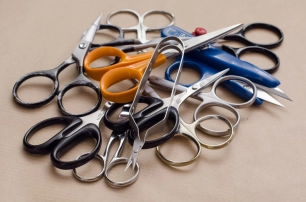
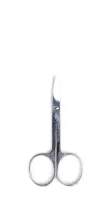

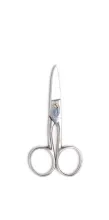
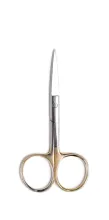

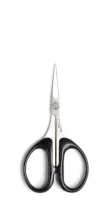
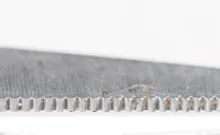
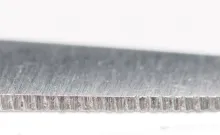
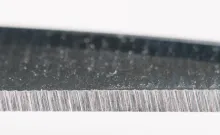
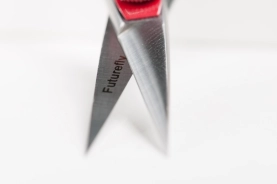
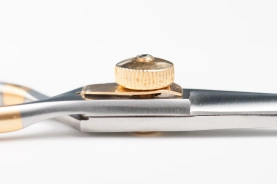
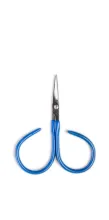
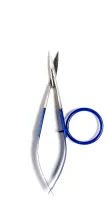
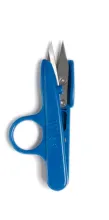
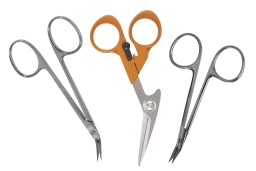
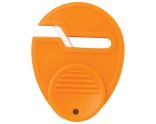
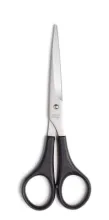
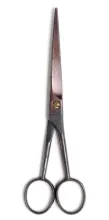

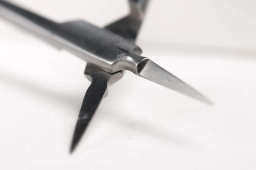
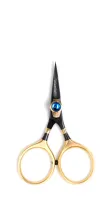
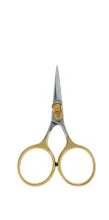
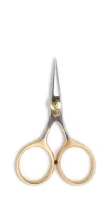
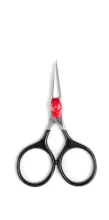
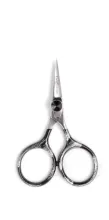
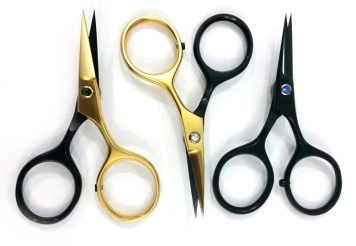
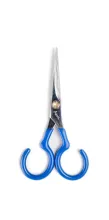
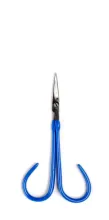
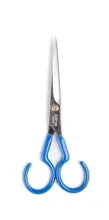
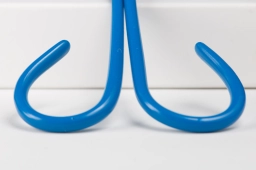
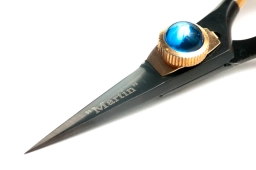
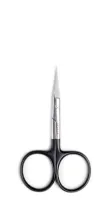
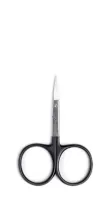
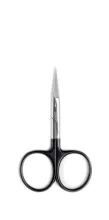
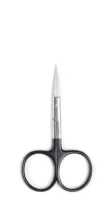
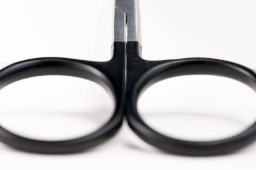

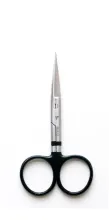
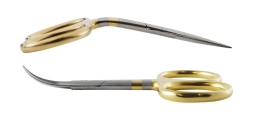
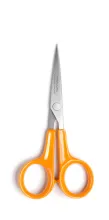
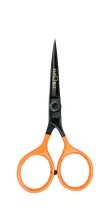
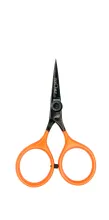
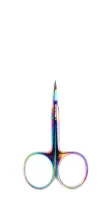
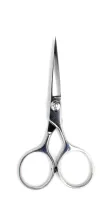

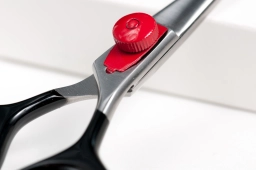
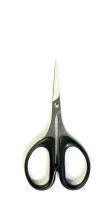
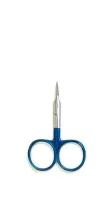
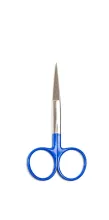
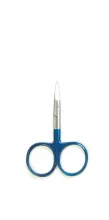

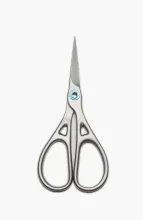
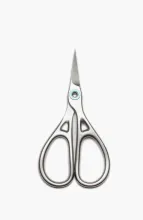

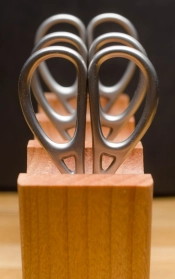
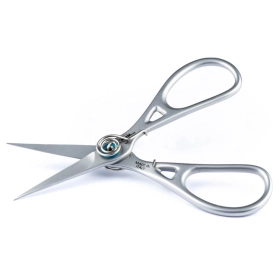
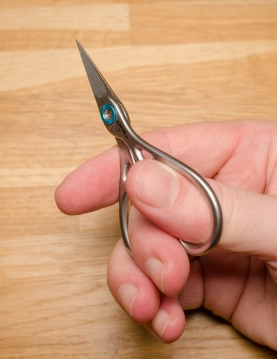

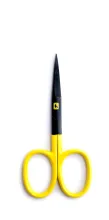
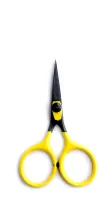
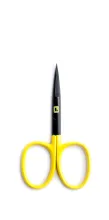
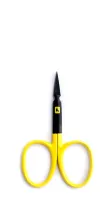
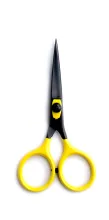
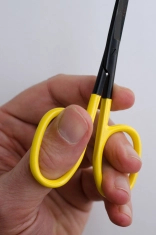
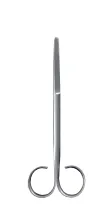
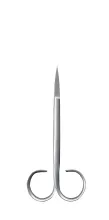
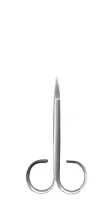
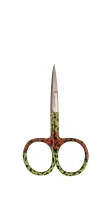
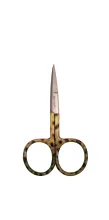
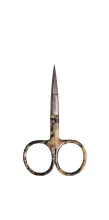
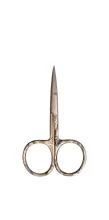
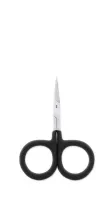
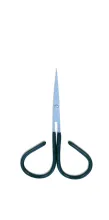

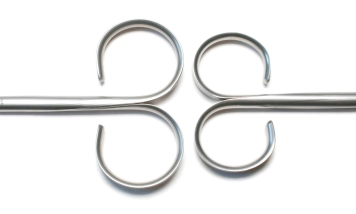
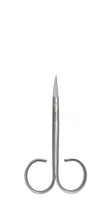
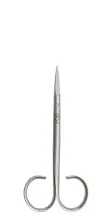

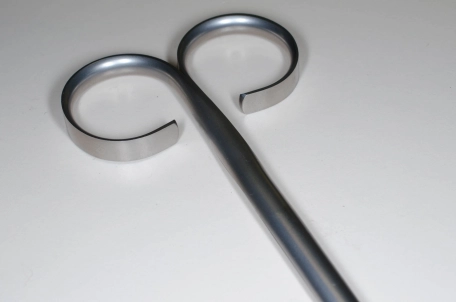
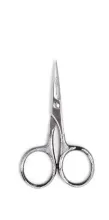
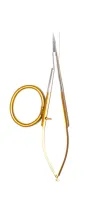
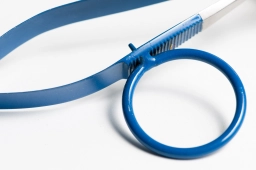
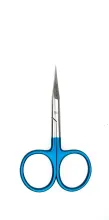
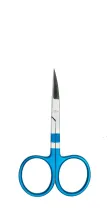
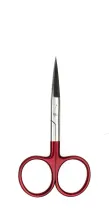
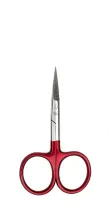
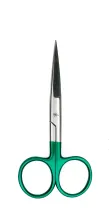
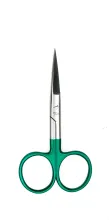
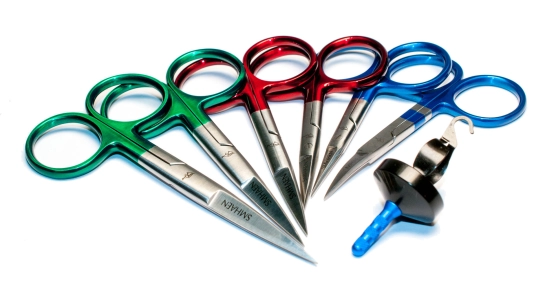
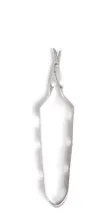
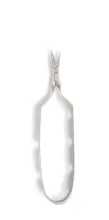
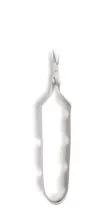
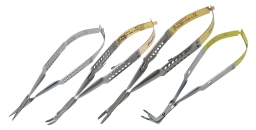
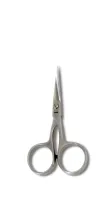
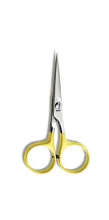
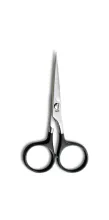
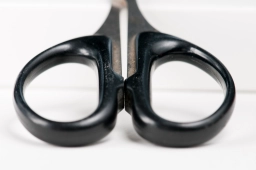
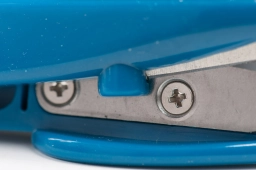
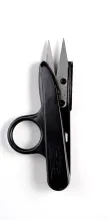
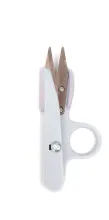
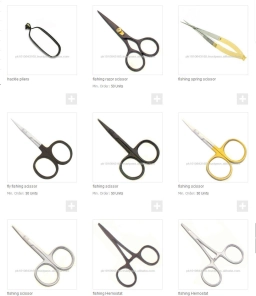
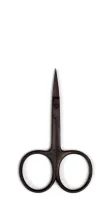
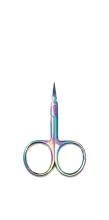
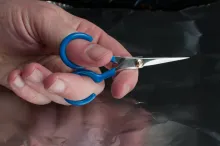

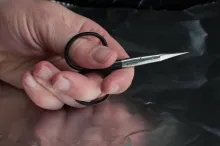
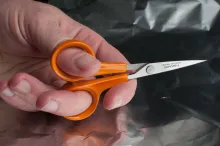
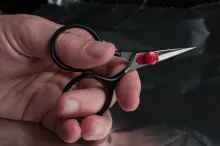
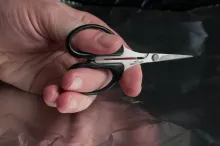
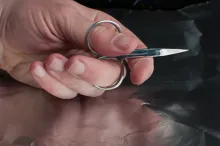
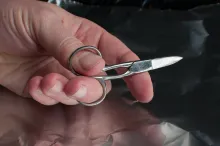
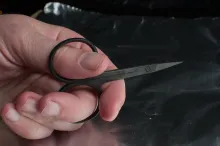
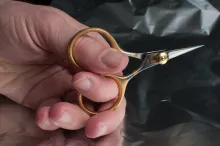
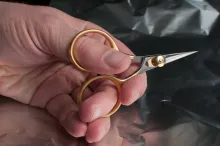
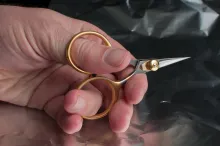
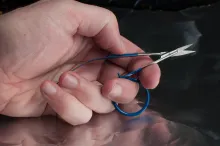
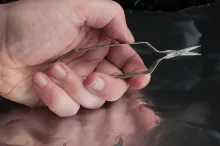
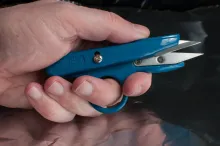
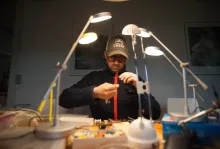
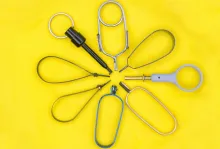
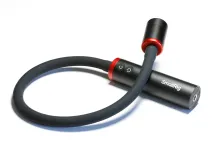
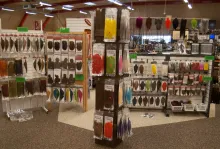
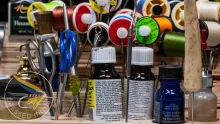


should have included
should have included this in my comment...if you hold your two hole scissors like the thread snips ( middle finger in bottom hole the top hole resting in your palm) you multiply the force with which you cut and don't need to lay your tool down between cuts.
you can sharpen scis
you can sharpen scissors with rod-type ceramic knife sharpeners (two rods in a wooden block)...just close the scissors on one of the rods once or twice.
there is a type of scissors called electrician's snips that look like your pharmacy scissors. they are similar to upholstery scissors.
they aren't cheap.
here in the states you can find them in most big box home stores.
there isn't much you can't cut with them. I use mine primarily for cutting wire and foam.
I admire your passio
I admire your passion and integrity exemplified by the thoroughness and fairness in this useful/well written article. Thank you
Jari,
I'm sorry a
Jari,
I'm sorry about placing Fiskars in Sweden. I know it's Finnish and knew it when I wrote the article. It must have been a Freudian slip... It's been corrected.
Martin
Very Nice Article!
Very Nice Article!
Not to be overlooked are medical/scientific supply firms that carry an extensive range of scissors from very expensive titanium edged scissors made by firms such as Biomedical Research Instruments to very reasonably priced knock-off surgical scissors from India, Pakistan and China
I bought a pair of t
I bought a pair of the Solingen curved double serated scissors at whitetail a couple of years ago, and I can tell you;
those are very good, I do a lot of deerhair tying and these are truly great, a must have for shaping Dahlberg diver heads for example.
Fiskars is FINISH co
Fiskars is FINISH company , founded in 1649.
Renomed scissors rock !
Hi Martin,
Thanks for taking the time to sum up so many scissors in your article. I've tried so many makes and types of scissors so far and I've never been fully satisfied with them. My two must have criteria for the tying scissors are sharpness of course and thin blades (often I need to cut materials right at the very tying point of the hook or tube). For a couple of years I've been using scissors made by Polish company Renomed and those are the best I've ever come across. If you're still looking for the ultimate fly tying scissors then you should definitely try them.
All the best,
Janusz
access in usa
What a great article but I wish some of them were available in USA. I tried some of the anvils and loons but the tips are surprisingly thick for delicate work. Any suggestions on a thin tipped (and pointy) pair that might be available in the states? I'm back to using a pair of MFC razors I picked up at a show until I can find something for my small ties.
Most of them are
David,
Most of the scissors covered in the article are very widely available, and should be particularly easy to get a hold of in the US! It's mostly us in Europe and Asia who have a hard time getting stuff... Sure, the ones from Romania are far away from the US (but unfortunately also discontinued now), but the ones from the UK should offer no problems. The rest should be available online or in shops in the US.
In the case of all of the brand name scissors there are links to either manufacturers or distributors, and I'm sure they can all supply names of resellers - brick and mortar or online - which you can use.
Regarding the points, there are several options. The razor scissors are basically all very thin in the points, but not all cut equally well close to the tips. It's best to test before buying if possible. The Squizzers are made for really fine work, and Loon's Ergo Arrow Point Scissors as well as the Renomed scissors are all very good in the tips.
Also remember that you can improve the tips your existing scissors by using the method shown by Wayne Luallen in the video Tool Tip: Sharpening Scissor Tips in our Tying Tips series.
I hope this helps.
Martin
Renoned scissors compared to Tiemco
Martin, first thank you for your extensive research on scissors. Bravo!!! I have been leaning towards a pair of Tiemco tungsten Carbide razor scissors and the Deer Dresser Scissors also by Tiemco. That was until I read your comments about Renomed. In a video put on by Fish Food Fly, a shop in Utah, the owner compared the points of a variety of different scissors. The Tiemco scissors came to the finest points. Do you think the Renomed match the fineness of the Tiemco points?? You’ve had your Tiemco for more than 25 years. Why do you think the Renomed scissors are better than the Tiemcos?? Any help making my decision is very appreciated. Thank you Martin. Jed Feffer
I still prefer Renomed
Jed, (sorry for my mistaking your name when first posting)
I find the Renomed scissors superior to various razor scissors that I have tried. I haven't used the Tiemco razors, but only their coarser Deer hair scissors, which I indeed have had and used for decades, but also have degraded to rougher work. Their tips are no nearly as fine as those of the razor models or the pointed Renomed models.
As mentioned in the article, most (read: all) razor scissors seem to come out of the same mold, just being branded differently by the sellers. You can find some inexpensive no-name razor scissors to try. In my experience they are exactly the same as the more expensive brand name models. The Renomeds are unique and unlike other scissors on the market, and my preferred tool in my day-to-day tying. But they are of course also quite expensive.
I hope this helps
Martin